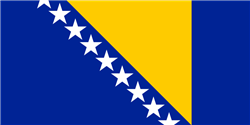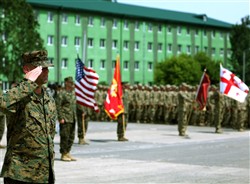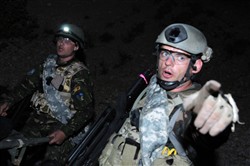Global medical practitioners work to seamlessly integrate
U.S. Air Force Tech. Sgt. Phillip Hines, U.S. Air Force School of Aerospace Medicine, demonstrates how to splint an arm with a structural aluminum malleable splint during the Critical Lifesaving Skills for First Responders course here May 29, 2012. During the course, instructors from the Defense Institute for Medical Operations worked with other countries' medical practitioners attending Shared Resilience 2012 to exchange medical ideas and techniques. More than 500 military members from nine nations are participating in the annual U.S. Joint Chiefs of Staff-sponsored exercise May 28 - June 8. The goals of the exercise are to strengthen interoperability, facilitate training in crisis response and disaster management, and validate the readiness of deployable military medical and humanitarian assistance teams. The exercise, in the spirit of partnership for peace, directly supports U.S. European Command's theater cooperation efforts and strategy for active security with European countries.
Related Topics (4)
More related topics
CAPLJINA, Bosnia and Herzegovina - Instructors from the U.S. Defense Institute for Medical Operations are exchanging ideas and techniques with medical practitioners from the different countries participating in Shared Resilience 2012 May 28 - June 8 here.
The information flow is driven from a class titled "Critical Lifesaving Skills for First Responders" and focuses on the basic steps to save lives at the very onset of injury.
"We're not trying to get the students to do things our way," said Master Sgt. Joe Coyle, a course instructor from Joint Base San Antonio, Texas. "We want the students to take something of value and use it in their communities in their own specific way to improve the care given to patients."
The institute is a dual service agency composed of Air Force and Navy service members who provide regionally focused healthcare education and training to partners around the world. So far, the instructors have worked with more than 7,000 people in the global medical community in hopes that if a medical emergency were to happen, the responders — regardless of nationality — would seamlessly integrate to provide the best care possible.
"It's like working with an old friend again," said U.S. Air Force Col. Joe Schmid, course director and mobilization assistant to Air Force Medical Operations Agency at JBSA. "The course fosters a learning atmosphere; we learn as much from them as they do from us. There are always different customs and local rules that we may not be familiar with."
Schmid said that one of the challenges of being a first responder in this region is the ability to medically assess and treat injuries in austere conditions with limited resources, especially at sites of natural disasters. Earthquakes or floods, for instance, cause widespread damage and usually affect electricity. Some of a medical facility's advanced equipment is rendered useless without electricity.
"Stick to the basics — that's when you start saving lives," said 2nd Lt. Warren Carter, course instructor from San Antonio Military Medical Center at JBSA. "The skills I've gained working in the [emergency room] can help those out in the field. They see the patient first, so what happens then is vastly important."
DIMO developed the lifesaving skills course as a refresher for improving basic trauma skills for first responders since critical lifesaving skills can reduce preventable deaths from traumatic
injury. The course is taught in a way so the attendees can share in lectures and demonstrate their medical capabilities during skill stations at the end of each day's instruction.
"The language barrier is a little difficult," Coyle said, "but there is one universal standard of taking care of people."
SR12 continues with exercises planned to test the joint capabilities discussed during the DIMO course. The exercise is an annual U.S. Joint Chiefs of Staff-sponsored exercise with a goal to strengthen interoperability; facilitate training in disaster management and crisis response; and validate the readiness of deployable multinational medical and humanitarian assistance teams.
Find more articles tagged with:
- Macedonia
- partnership
- Army
- exercise
- Airman
- Montenegro
- Soldier
- Serbia
- Croatia
- Slovenia
- medical
- multinational
- Immediate Response
-

Despite the cold: U.S. military partnerships key to Arctic crisis response
The scenario used during SAREX 2012— a multinational exercise held recently in Greenland’s eastern sea – tested military and civilian capabilities for search and rescue missions above the Arctic Circle. Meanwhile, during exercise Northern Eagle, a U.S. Navy destroyer joined Russian and Norwegian vessels in the Barents Seas to prepare for similar rescues, plus anti-piracy operations and joint air defense.Find more articles tagged with:
-
Civic leaders receive preview of Baumholder's future
Leaders of the U.S. Army Garrison Baumholder, the 170th Infantry Brigade Combat Team and local civic leaders came together for a garrison hosted civic leaders working luncheon recently in the Rheinlander Community Club to discuss issues affecting the military and civilian communities.Find more articles tagged with:
-

USACE forward engineers train with Italians
A U.S. Army Corps of Engineers Forward Engineering Support Team-Advance (FEST-A) conducted training and remote engineering missions in partnership with Italian Army Reconnaissance Engineers here September 9-21, 2012.Find more articles tagged with:
-

EIAMDC officially opens
The Warrior Preparation Center opened the European Integrated Air and Missile Defense Center with a ribbon cutting ceremony here Sept. 26.Find more articles tagged with:
-

Exercise Jackal Stone 2012 leaders, participants honor fallen SF comrade
Military members and civilians from the U.S. and Croatia honored the late Master Sgt. Ivica Jerak, a member of U.S. Army Special Operations Command, with a small memorial service held in his native town of Debeljak, Croatia, Sept. 22, 2012.Find more articles tagged with:
-

Schweinfurt flexes combat capability muscle with NATO exercise
Despite its announced closure earlier this year, the U.S. Army garrison here still has something to prove: Pitted between closing and remaining operational, it can also host a large-scale NATO exercise in its own backyard.Find more articles tagged with:
-

Ceremony ends 18th Combined Endeavor
On Sept. 20, a closing ceremony at the Joint Military Training Command on U.S. Army Garrison Grafenwoehr, Germany, ended the 18th year of the world’s largest military communications exercise, Combined Endeavor 2012.Find more articles tagged with:
-

173rd Airborne Brigade, Italian carabinieri share training, experiences
Noncommissioned officers from the rear detachment of U.S. Army Europe's 173rd Airborne Brigade Combat Team shared deployment experiences and lessons learned with Italian military law enforcement officers during cultural awareness and information operations training here, Sept. 11.Find more articles tagged with:
-

Operation Rhino Serpent 2012: US, German, British medical troops learn from one another during exercise
Operation Rhino Serpent, a multi-national medical field training exercise comprised of more than 550 U.S. Army Europe, German Armed Forces and British Armed Forces active duty Reservists and volunteersFind more articles tagged with:
-

Kansas National Guard partners with HDTC for Humanitarian Demining in Armenia
Four soldiers from the Kansas National Guard are working with a civilian representative from the U.S. Humanitarian Demining Training Center to teach international Humanitarian Mine Action standards to members of the Engineering Companies of the Armenian Peacekeeping Brigades Sept. 18-28.Find more articles tagged with:














Comments: 0